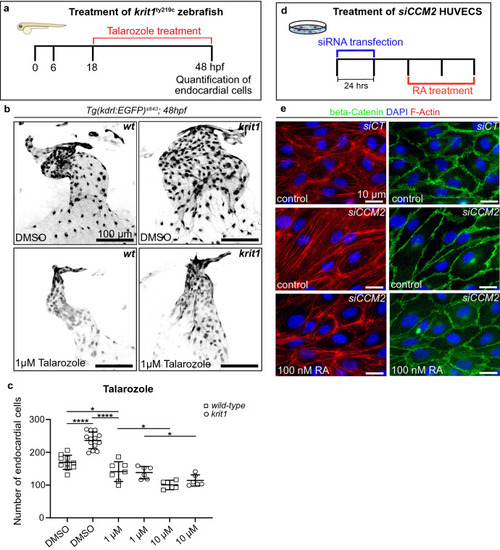- Title
-
Impaired retinoic acid signaling in cerebral cavernous malformations
- Authors
- Grdseloff, N., Boulday, G., Rödel, C.J., Otten, C., Vannier, D.R., Cardoso, C., Faurobert, E., Dogra, D., Tournier-Lasserve, E., Abdelilah-Seyfried, S.
- Source
- Full text @ Sci. Rep.
|
Expression of retinoic acid pathway components is misregulated in in vitro and in vivo models of CCM. (a) Retinoic acid synthesis and degradation pathway. Synthesis of retinoic acid from Vitamin A (retinol) is dependent on availability of NADPH. In this study, all-trans RA and the Cyp26 inhibitor Talarozole were used to modulate RA levels. (b) Comparative expression levels of RA pathway genes in ccm2 mutant zebrafish hearts, pan-endothelial Ccm2 knock-out mouse veins, and siRNA CCM2-depleted HUVECs. Fold changes in expression levels are depicted in circle sizes (grouped by fold changes between 0 and 5, see legend). Downregulated transcripts are represented with blue circles whereas upregulated genes are shown in red circles. Transcripts not represented in the datasets do not contain a circle. Gene names are represented as human orthologs except for genes for which only co-orthologs are known (marked with asterisks). (c) Whole-mount in situ hybridization of raldh2 performed on 72 hpf old zebrafish and magnifications of the heart region (see box). Stained valve leaflets are marked by an arrow. EXPRESSION / LABELING:
PHENOTYPE:
|
|
Curative effects upon Talarozole treatment of krit1 mutant zebrafish and retinoic acid treatment of siCCM2 depleted HUVECs. (a) Treatment scheme for zebrafish from 18 to 48 hpf using Talarozole. Endocardial cell numbers (a readout for CCM-associated cardiac phenotype in zebrafish) were analyzed after treatment in two independent experiments. (b) Representative images of zebrafish heart morphologies visualized by the transgene kdrl:EGFP at 48 hpf after treatment. Upper: heart morphology of controls treated with DMSO. Lower: hearts treated with Talarozole. Scale bars: 100 µm. (c) Endocardial cell counts at 48 hpf of zebrafish treated with several doses of Talarozole or DMSO (*P < 0.05; ****P < 0.0001 vs. control). Each data point represents one heart. (d) Treatment regimen of HUVECS. SiRNA transfection was done for 24 h, followed by treatment with RA 24 h later. Cell morphologies were analyzed after 48 h of incubation and antibody staining. (e) Immunohistochemistry of HUVECS for beta-catenin, F-actin, and DAPI. First column: control cells (siCT) with wild-type CCM2 expression. Second column: untreated siCCM2-depleted HUVECs. Third column: representative image showing siCCM2 HUVECs treated with 100 nM RA. Scale bars: 10 µm. |
|
Curative RA trial in BECiCcm2 mice. (a) Treatment regimen with brain-endothelial-cell-specific gene ablation at P1 followed by RA treatment at three months of age for a period of 3 weeks (10 mg containing pellets with a release of ~ 20 mg/kg/day for 21 days). (b) Extracted BECiCcm2 mouse brains after treatment. Upper: placebo treated controls. Middle: brains after 10 mg of RA treatment. Black arrows indicating hemorrhage, white arrows pointing at visible lesions. Lower: histological sections of cerebral cavernous malformation (CCM) lesions after treatment. Perls blue stain reveals non-heme iron deposition. Scale bars: 1 mm (upper and middle); 100 µm (lower). (c) Quantification of lesion burden in cerebella of placebo versus 10 mg RA treated mice. Lesions are quantified in three groups according to their size. Each datapoint represents one animal. Error bars represent mean with SD. (d) Quantification of lesion area as percentage of total area analyzed (*P < 0.05). (e) Quantification of Perls blue staining positive area per total area analyzed (*P < 0.05; **P < 0.01). Error bars represent mean with SD. |
|
Assessment of KLF2/4 mRNA expression in treated animal models of CCM. (a) Expression levels of treated BECiCcm2 mouse cerebella after curative RA treatment (~ 20 mg/kg/day for 21 days) as mean fold changes determined by qRT-PCR. (ns = P > 0.05; **P < 0.01;***P < 0.001;****P < 0.0001 vs. control). Each data point represents one sample. Error bars show mean with SD. (b) Fold changes of KLF2/4 mRNA expression in siCCM2-transfected HUVECs treated with RA for 48 h compared to untreated cells (*P < 0.05; **P < 0.01). Each data point represents one sample. (c) Whole-mount in situ hybridization of klf2a in 48 hpf zebrafish embryos treated with DMSO or Talarozole. |




